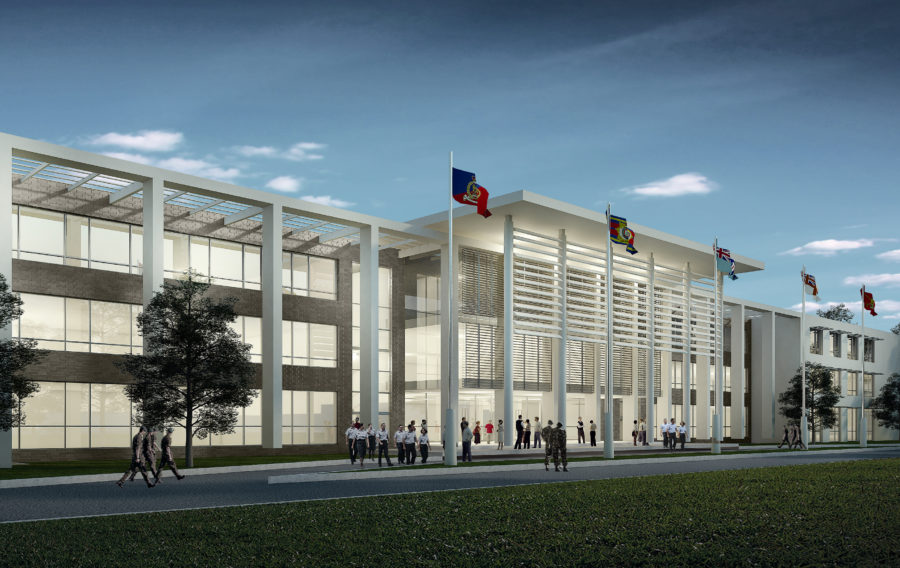
The Defence Infrastructure Organisation (DIO) is working on a £300 million project to deliver the new Defence College of Logistics, Policing and Administration (DCLPA) at Worthy Down. Defence Online editor Matt Brown speaks with Sally Groom, Senior Environmental Advisor at Skanska – principal contractor and DIO’s industry partner on the project – to discuss improving the environmental performance of the buildings on–site through renewable energy solutions.
The Ministry of Defence is no different from other organisations in its demand for efficiency and saving expenditure. What role does renewable energy play in this?
In applying renewable energy strategies, efficiencies in expenditure and process often go together. Skanska’s core strategy, the Journey to Deep Green, promotes the investigation, design and use of renewable energies, alongside reducing demand where it works for both the environment and the client. Achieving Deep Green is the standard all projects work towards and energy is one of the keystones in that. The MOD’s Sustainable Procurement Strategy aligns with our core strategies so we enjoy a collaborative relationship to gain cost-effective and sustainable energy production.
In the first phase of the project, photovoltaic (PV) cells were installed on two of the roofs, which are capable of providing power to on average one hundred homes. The annual yield produced will be just under 326,000kWh, with just one set of PVs saving approximately £50,000 per year. This is a great example of renewable energy both providing sustainable practice and saving our client cost.
Skanska has worked with the MOD over a number of years. How has the demand for greener energy changed over the last decade?
With the carbon intensity of producing power targeted to be below 100kg CO2 per kW by 2030 by government advisors, there has definitely been an increased demand for more sustainable means to generate and use power. The change in demand for greener energy is changing the face of industry and research and development.
As a result, Skanska takes a three-pronged approach to energy in buildings. We first assess the potential for reducing energy demand, designing out energy wastage and optimising the building specification for heating and ventilation. Then, we look at how efficiently the building services can be managed, thereby further reducing energy demand. Lastly, we assess the best sources to provide the remaining required energy – this will include renewable technologies and low or zero carbon technologies, where appropriate. At Worthy Down, one of our solutions is gas fired boilers in centralised energy centres with localised heating systems to all new buildings. This ensured a robustness of design, economies of scale and reduced maintenance as well as being a very energy-efficient solution.
How have advancements in technology changed the way you manage energy on your projects?
The explosion in renewable energies markets worldwide has caused solar and wind generation to become significantly more efficient in just a few short years, and this will only continue to improve. The International Renewable Energy Agency has found the cost of solar panels has fallen by 80% since 2009. This means our clients are now finding it more financially accessible to achieve their desired environmental outcomes.
At Skanska, we have resources specifically allocated to life-cycle costing. We complete a cost-benefit exercise for the application of alternative solutions for our clients, providing the capital cost against the operational cost. At Worthy Down, we assessed that wind turbines and biomass fuel were not appropriate due to logistical and planning issues, but PV would work very well. We have incorporated LED lighting and low water usage showers and taps in addition to PV panels. Advances in technology also mean we can now monitor the effectiveness of such installations using a building energy management system.
Typically, where can the biggest savings usually be made in carbon emissions?
By factoring in embodied and operational carbon. At Skanska, we’re looking at the materials and products we procure – how they were sourced, manufactured and transported – and the way we manage the materials or the waste we produce from our work. For example, at Worthy Down we produced 11,800 cubic metres of material from demolition. It was crushed on-site and used for building platforms, crane and piling mats, a temporary haul road, formations for slabs, etc. We saved 5.82 tonnes of CO2e.
Each of the buildings at Worthy Down is subject to a DREAM assessment, which includes the achievement of credits during the operational phase, after we hand over to the customer. This gives structure to the opportunities available; some options for reducing carbon emissions then might include having an energy action plan to reduce energy usage based on monitoring the installed meters, or having a carbon reduction plan, involving a streamlined and efficient vehicle fleet and maintenance.
Worthy Down’s Defence College of Logistics, Policing and Administration is clearly a significant project for the MOD. What improvements has the project made to the environmental performance of the building?
Although there are a variety of considerations in sustainable building design, one of our main focus points is using passive design to make use of the local climate. This reduces not only the need for auxiliary heating or cooling and the attendant capital cost but also the operational cost due to less maintenance. The planning requirement was to achieve 10% of the site’s regulated energy from renewables, which we are on target to achieve.
The building fabric was designed to minimise heat losses and heat gains to the spaces by factoring in materials’ U-values. This has reduced and, in some cases, eliminated the need for building services plant and equipment. As well as openable windows for ventilation we also designed for ‘windcatchers’, units that facilitate the movement of natural ventilation in larger areas, such as the main bar, at certain times of the year. To make the most of natural light and reduce the amount of energy needed for lighting, 3D modelling was used to design well-lit spaces while limiting overheating and glare.
When we arrived on-site, the predicted water loss through leaking pipes and inefficient appliances was 50%. Skanska has installed a completely new potable water system and is in the process of replacing old pipes to help the College conserve water more effectively.
How challenging is it to hit environmental targets while retaining full operational ability?
It can be challenging, though the Worthy Down project appointed a full-time Logistics Manager to coordinate all the movements between buildings as the work progressed, and deal with any operational issues for staff and students. This has been a great benefit to both Skanska and the MOD.
An area dedicated to the crushing of reusable material and the remediation of some contaminated ground greatly helped the coordination of on-site activities, keeping some operations separate from our main areas and avoiding unnecessary impact on MOD staff. We found a tawny owl in one of the buildings being constructed and we managed a short-term exclusion zone while keeping the building operational. There was also a pond with a lively community of smooth newts and frogs, which needed moving before constructing the first phase. It will then need moving again before the third construction phase, and coordination with the MOD has resolved any on-site issues smoothly.
Targets such as how effectively we divert waste from landfill during the construction phase aren’t really impacted by operational ability.
What challenges does bringing the existing MOD estate in line with environmental targets present in comparison to a new project?
With new builds you have complete control over not only the build itself, but the working environment. Working on an existing MOD estate means a lot more collaboration in achieving targets and standards across the board.
The removal and refurbishment of existing buildings and infrastructure changes the way we manage materials, energy, waste, ecology and contaminated land issues. You have to see the opportunities to work with the existing provision and design to complement them. It may be that some of the original building stays in place, or it may be that, as with our on-site crushing, you make use of the materials already available to you.
One of Skanska’s strengths is being able to work collaboratively with its clients and partners to ensure the business continuity of any operations.
In terms of ongoing site maintenance, can greener power solutions reduce life–cycle costs?
Yes, they definitely can. It is just as possible to reduce life-cycle costs through good maintenance as it is by constructing a building using materials considered and designed for their reduced life cycle. Once the building is handed over to the client, further life-cycle costing calculations are done to ensure the operation and maintenance plans are fully optimised. For example, on a residential project we did in Finland, over the selected period of 40 years the two most costly alternative solutions in the investment phase were actually the most affordable from a life-cycle cost perspective.
For more information, visit: www.skanska.co.uk
If you would like to join our community and read more articles like this then please click here
DCLPA Defence Infrastructure Organisation Sally Groom Skanska Worthy Down







